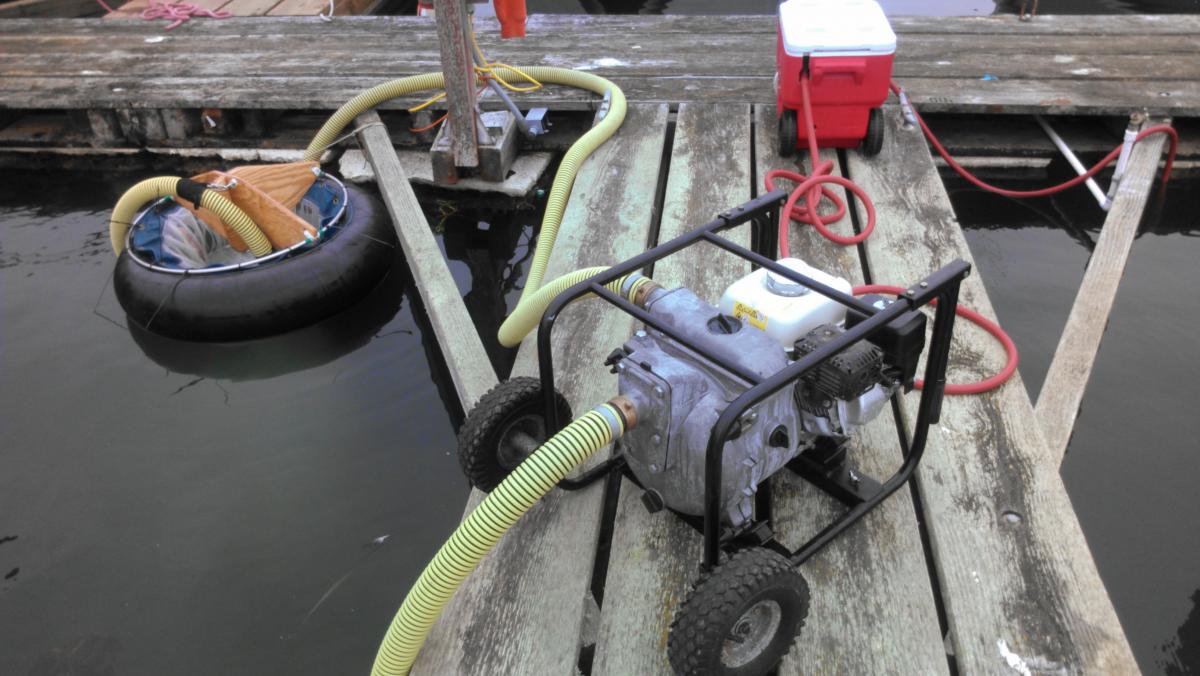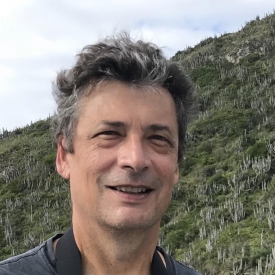
Inevitably at each marina we visit there are questioning looks by patrons, raised eyebrows as we lug nearly 400 pounds of equipment around the docks, and eventually the one spectator who walks up to us and asks, “Are you salvaging a sunken boat?” To which we respond, “No, but we’re glad you asked. We are looking for zooplankton!”
The sunken boat question is not surprising given the large amount of supplies we have in tow, especially with a trash pump as our key piece of sampling equipment. When we collect zooplankton from the middle of bays in deep water, we can tow a net behind a boat. The challenge comes when sampling the high-traffic waters of ports and marinas where concentrations of zooplankton can be quite low. Towing a net behind a boat just won’t work in these areas. Instead, we use a portable pump system created by George Smith using an industrial/agricultural ‘trash-pump’ (affectionately named Big Bertha).
George says he chose this pump because it is "designed to move a lot of water quickly without regard to there being leaves, big-mac wrappers, old cigars, or whatever mixed in, up to a certain size anyway. I think Big Bertha can pass solid objects up to about 1.5” diameter and larger objects if more-or-less squishy". The water is pumped through a fine-mesh net, filtering out and concentrating the zooplankton we want to study.
Our goal is to detect new invasive species in the zooplankton, if there are any. Zooplankton are a diverse group of organisms that live in the water column for all or part of their lives, and include animals like copepods and the early (larval) life-stages of many larger animals like crabs, fishes, and shellfish.
Our estuaries have been invaded by hundreds of nonnative species. These species are spread in many ways, but the primary pathway for introduced plankton introductions (both zooplankton and phytoplankton) is ballast water. Large ships use ballast water for weight and balance, and in turn transport millions of gallons of water from foreign ports annually. When this water is not treated, a diverse assemblage of non-native plankton can be released as the ballast tanks are discharged. Many of these organisms do not survive, but the ones that do survive and establish populations in our ports can have major ecological and economic impacts in coastal ecosystems.
Regulations mandate that vessels undergo a mid-ocean ballast water exchange while at sea: the coastal, port water is flushed from the ballast tanks into the open ocean and subsequently replaced with ocean water. The primary goal of this management strategy is to reduce the number of coastal organisms transferred in ballast water discharged by vessels travelling from port to port. As a result of ballast water management, we predict a reduction in new invaders over time.
Since 2012, Arianne Balsom, Ruth DiMaria, Darrick Sparks, and others have collected zooplankton from bays with major commercial ports, a known source of introduced marine species, and smaller bays without a direct route for invasion overseas. The waters we visit border all three coastlines and include San Francisco, Tampa, and Chesapeake bays, as well as smaller estuaries in California and the Pacific Northwest. We conduct these bay-wide surveys to document changes in the zooplankton community and invasion dynamics over time.
Collaborating with experts, we identify the zooplankton species in our samples, both visually and with molecular techniques. To determine where a species originated, we look at both the body features (morphology) and DNA fingerprints (genetics) of each organism. As we continue to accumulate these data, we can begin to estimate where the “hot spots” of invasive species occur and also the effect of current management strategies (like ballast water treatment) to reduce new invasions.





